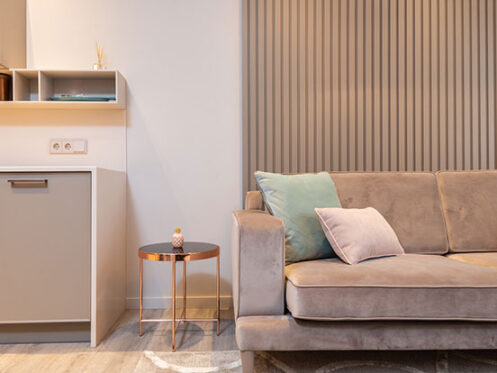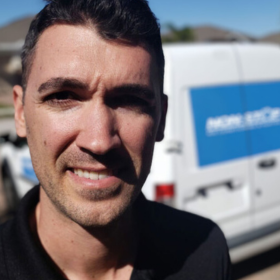Indoor Air Pollution and Health
According to United States Environmental Protection Agency, Indoor Air Quality (IAQ) refers to the air quality within and around buildings and structures, especially as it relates to the health and comfort of building occupants. Understanding and controlling common pollutants indoors can help reduce your risk of indoor health concerns.
Health effects from indoor air pollutants may be experienced soon after exposure or, possibly, years later.
Immediate Effects of Poor Air Quality
Some health effects may show up shortly after a single exposure or repeated exposures to a pollutant.
- irritation of the eyes, nose, and throat
- headaches
- dizziness
- fatigue
Certain immediate effects are similar to those from colds or other viral diseases, so it is often difficult to determine if the symptoms are a result of exposure to indoor air pollution. For this reason, it is important to pay attention to the time and place symptoms occur. If the symptoms fade or go away when a person is away from the area, for example, an effort should be made to identify indoor air sources that may be possible causes. Some effects may be made worse by an inadequate supply of outdoor air coming indoors or from the heating, cooling or humidity conditions prevalent indoors.
Long-Term Effects of Poor Air Quality
Other health effects may show up either years after exposure has occurred or only after long or repeated periods of exposure.
- asthma
- respiratory diseases
- heart disease
- cancer
Primary Causes of Indoor Air Problems
Indoor pollution sources that release gases or particles into the air are the primary cause of indoor air quality problems. Inadequate ventilation can increase indoor pollutant levels by not bringing in enough outdoor air to dilute emissions from indoor sources and by not carrying indoor air pollutants out of the area. High temperature and humidity levels can also increase concentrations of some pollutants.
Pollutant Sources
There are many sources of indoor air pollution. These can include:
- Fuel-burning combustion appliances
- Tobacco products
- Building materials and furnishings as diverse as:
- Deteriorated asbestos-containing insulation
- Newly installed flooring, upholstery or carpe
- Cabinetry or furniture made of certain pressed wood products
- Products for household cleaning and maintenance, personal care, or hobbies
- Central heating and cooling systems and humidification devices
- Outdoor sources such as:
- Radon
- Pesticides
- Outdoor air pollution
- Asbestos
- Biological Pollutants
- Carbon Monoxide (CO)
- Formaldehyde/Pressed Wood Products
- Lead (Pb)
- Nitrogen Dioxide (NO2)
- Pesticides
- Radon (Rn)
- Indoor Particulate Matter
- Carbon Monoxide (CO)
- Secondhand Smoke/ Environmental Tobacco Smoke
- Stoves and Heaters
- Fireplaces and Chimneys
- Volatile Organic Compounds (VOCs)
- Location of ducts- If your ducts are in hard-to-reach locations like behind the walls or in a small crawlspace, they will be more expensive to clean. However, most of the time ducts are located in fairly easy-to-reach places like attics.
- How dirty your ducts are- The dirtier your ducts are, the more expensive your duct cleaning will be. This is mostly due to the fact that dirtier ducts will take a technician longer to clean, especially if there is an excessive build up of dust and/or debris.
- Size of your home- The larger your home is, the more ductwork you likely have, and the more expensive your duct cleaning will be.
Learn more about indoor air pollutants and sources of:
Inadequate Ventilation
If too little outdoor air enters indoors, pollutants can accumulate to levels that can pose health and comfort problems. Unless buildings are built with special mechanical means of ventilation, those designed and constructed to minimize the amount of outdoor air that can “leak” in and out may have higher indoor pollutant levels.
How Outdoor Air Enters a Building
Outdoor air can enter and leave a building by: infiltration, natural ventilation, and mechanical ventilation. In a process known as infiltration, outdoor air flows into buildings through openings, joints, and cracks in walls, floors, and ceilings, and around windows and doors.
How to Maintain Good Air Quality?
Air Filtration
The most effective ways to improve your indoor air are to reduce or remove the sources of pollutants and to ventilate with clean outdoor air. In addition, research shows that filtration can be an effective supplement to source control and ventilation. Air purifiers contain either HEPA, HEPA-type, or permanent washable filters. Many also contain activated charcoal prefilters. It removes 99.97% of the microscopic allergens that pass through the filter. These include dust mites, pollen, pet dander. These are whole-house devices that integrate directly into your ductwork to filter out a wide range of harmful particles and contaminants.
Ultra Violet Lights
Natural ultraviolet (UV) light from the sun keeps airborne microorganisms under control outdoors. EZUV kills airborne viruses, bacteria and allergens and keeps the interior surfaces of your HVAC system free of mold and other biogrowth. This means you’ll have healthier air, and a more efficient HVAC system that uses less energy! And, EZUV can reduce—often eliminate— expensive chemical coil cleanings. So you’ll save energy and cleaning expenses while helping protect the environment!
Dehumidification Systems
One of the most distinctive traits about your home’s indoor air quality is the humidity level & climate. You have likely used a dehumidifier in your Southwest Florida, home at some point or another, but a whole-house dehumidifier is a different system entirely. These are highly effective and efficient.
Regular Air Duct Cleaning
Cost Factor
Contact Southwest Florida’s Most Trusted HVAC Contractor
At Non-Stop Air Conditioning & Heating, we provide excellent indoor air quality services throughout the Charlotte county, Lee county, and Collier county area, including the installation of whole-home residential air purifiers, filtration, and dehumidification systems.
Call us at (239) 522-8642 today or book a free estimate online to request HVAC cleaning and air quality filtration services.


